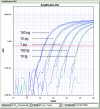Use of single nucleotide polymorphisms in the plcR gene for specific identification of Bacillus anthracis
- PMID: 15815042
- PMCID: PMC1081367
- DOI: 10.1128/JCM.43.4.1995-1997.2005
Use of single nucleotide polymorphisms in the plcR gene for specific identification of Bacillus anthracis
Abstract
A TaqMan-minor groove binding assay designed around a nonsense mutation in the plcR gene was used to genotype Bacillus anthracis, B. cereus, and B. thuringiensis isolates. The assay differentiated B. anthracis from these genetic near-neighbors and determined that the nonsense mutation is ubiquitous across 89 globally and genetically diverse B. anthracis strains.
Figures


References
-
- Agaisse, H., M. Gominet, O. A. Økstad, A. Kolstø, and D. Lereclus. 1999. PlcR is a pleiotropic regulator of extracellular virulence factor gene expression in Bacillus thuringiensis. Mol. Microbiol. 32:1043-1053. - PubMed
-
- Guignot, J., M. Mock, and A. Fouet. 1997. AtxA activates the transcription of genes harbored by both Bacillus anthracis virulence plasmids. FEMS Microbiol. Lett. 147:203-207. - PubMed
-
- Hill, K. K., L. O. Ticknor, R. T. Okinaka, M. Asay, H. Blair, K. A. Bliss, M. Laker, P. E. Pardington, A. P. Richardson, M. Tonks, D. J. Beecher, J. D. Kemp, A. Kolstø, A. C. L. Wong, P. Keim, and P. J. Jackson. 2004. Fluorescent amplified fragment length polymorphism analysis of Bacillus anthracis, Bacillus cereus, and Bacillus thuringiensis isolates. Appl. Environ. Microbiol. 70:1068-1080. - PMC - PubMed
Publication types
MeSH terms
Substances
LinkOut - more resources
Full Text Sources
Other Literature Sources
Medical

